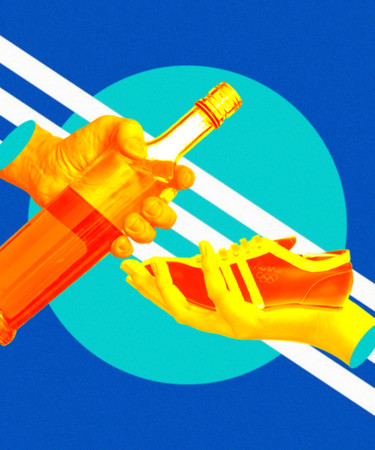The simple three-stripe design that has become synonymous with German sportswear mega brand Adidas is emblazoned on shoes, jackets, shorts, and T-shirts galore. The company reels in over $25 billion in revenue each fiscal year, second only to Nike in the sportswear category.
While the iconic logo is an instantly recognizable part of the Adidas brand today, that wasn’t always the case. The brand was founded in 1949, but it took until 1952 for the three-stripe logo to be trademarked. The hold up? Adidas realized another brand had come up with the same logo idea — and had already trademarked it for themselves.

With no intention to give up on its planned logo, Adidas struck a deal to buy the trademark from Finnish sports brand Karhu. After some good old-fashioned negotiation, they settled on a final price: Karhu sold the three-stripe design to Adidas for 1,600 euros — roughly $1,800 — and two bottles of whiskey.
Yep, you read that right. Adidas sealed the deal with booze.
Adidas has never officially confirmed the story of how it bought its logo, but lore has it that a deal was struck after the 1952 Helsinki Summer Olympics. Karhu was the footwear of choice for Finnish Olympic athletes at the time. Runners who wore Karhu won a total of 15 gold medals at the games. Adidas approached Karhu about purchasing its logo shortly thereafter.
After meeting in Germany to discuss the trademark sale, the two companies agreed on a final price of 1,600 euros, and Adidas threw in two bottles of whiskey. According to a former Karhu brand manager, there is no proof that whiskey was included in the deal — and no record of the type or price of the whiskey included in the trade — although the story is generally accepted by the brand as fact.
Adidas’ determination to own the three-stripe logo came from a combined interest in the function of and meaning behind the stripes. Initially, Adidas used stripes on its running shoes as stabilizing strips. The brand tried out combinations of two, three, and four stripes to determine which provided the best support for its track spikes. It settled on three and decided it wanted to trademark the logo as a way to symbolize the three continental markets it served at the time — Europe, North America, and Asia. The brand has since expanded globally.
Today, there are many iterations of the Adidas logo, including the popular trefoil and mountain — all of which incorporate the three stripes in various forms. The deal Adidas struck with Karhu is one that clearly paid off. And though it may appear that Karhu got the short end of the stick, the agreement is proof that good whiskey is priceless.
